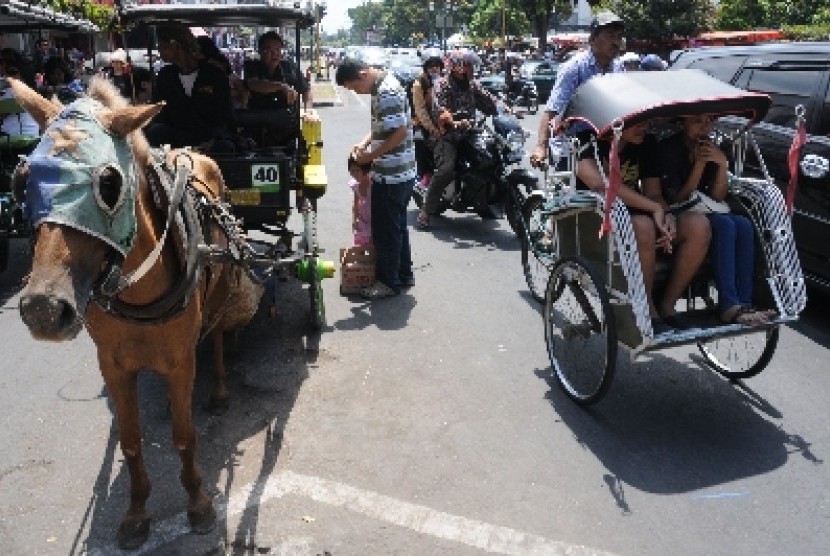REPUBLIKA.CO.ID, JAKARTA -– The sky was still dark. The sunlight seemed reluctant to shine the road along Sultan Agung Street, Medan Satria, Bekasi, West Java on Wednesday (April 5). The main street connecting Jakarta and Bekasi, hanged its lighting from the street lamps.
A pedicab (becak) driver crossed the street while boosting the pedal of his three-wheeled vehicle. I met him, Ata, in a pedicab base where he usually waits for his passengers. The man always use a conical hat made from woven bamboo that the Indonesian people usually called as “caping”.
Tidak ada kode iklan yang tersedia.
Ata had been working as a pedicab driver since 1990. He used to serve passengers around Kranji, Bekasi. He usually parked his pedicab in front of Kranji Station.
Together with his friend, Manto, whose pedicab was parked nearby, Ata used to boost his becak from Karawang to Bekasi. Manto had his own pedicab, while Ata had to rent. His pedicab was sold to pay his children’s tuition fees. As the result, he should pay for Rp 5.000 per day to the owner.
In the era of digital technology, Ata said his income was significantly decreased. The man from Karawang claimed that the pedicab’s heyday was over. The pedicab operation area was regulated by the local government. There was also an ‘attack’ from more attractive online transportation.
Regional Regulation No. 52 year 1998 stated that all main streets in Bekasi should be free from any pedicab and non-motorized vehicles such as cart, “andong”, and others. “ Ever since, it becames very hard to get customers because of the online ‘ojek’,” said the Sundanese with his thick accent.
Before the existence of online ‘ojek’, Ata could earned Rp 50 thousands per day. Beside that, he still got money for lunch. He and Manto could take five to seven passengers per day. But after the era of online ‘ojek’, they just could take two or three passengers. Each passengers should only pay Rp 10-15 thousands.
Besides the limited operation area, people’s interest to use pedicab had decreased. There were so many people joined online ‘ojek’.
Ata said it was very hard to save his money as he had very limited income to meet his basic daily needs. The rest of the income was only Rp 15-20 thousands per day. "In the past, I could save almost a million per week."
Rather similar story was told by another pedicab driver, Paryadi (45 yo). He usually parked his vehicle in front of Ananda Hospital, Pondok Ungu, Bekasi. He used to be a pedicab driver for about 25 years.
He took a long breath before starting his story. His eyes staring to somewhere while bitter smile was on his lips. “Complaining,” he said in a short word.
The man from Purwodadi said he often back to home without getting any passenger. However, he did not force himself to work. His children had been working, so he worked just to buy food for himself.
“I got home without getting any passenger for a week. I borrowed money from my relatives so I could buy some foods. When I had money, I could only used it to turn it back,” said him.
Although he kept complaining on the fate of pedicab drivers, Paryadi was sure on God had determined the provision of each believer.
Meanwhile, City Government of Bekasi often patrolled for seeking pedicabs in some main streets, among others Ir. H. Juanda Street, Ahmad Yani Street, Mayor Hasibuan Street, Cut Meutia Street, and Chairil Anwar Street. The Head of Local Regulation Enforcement Division of Civil Service Unit of Bekasi, Deddy Supriadi, confirmed it. “There have been a regulation and we routinely do it (patrols),” said him.
The caught pedicab owners would be administered by the civil service unit. They would be tried in the District Court of Bekasi for misdemeanor. The civil service unit also cooperated with Department of Transportation in Bekasi to make a special sign forbidding the pedicabs to cross the main streets.
Looking closer to the history, pedicab was a very familiar vehicle for Indonesian people. The first pedicab came to Indonesia in 1937, meeting the needs of Chinese traders. In 1940, pedicab was utilized as public transportation.
Its existence increased during Dutch colonization era. After the massive growth of pedicab owners, government forbid it to operate, as it endangered the safety of passengers and it caused traffic congestion.
The number of pedicabs was increasing again when Japan came to Indonesia in 1942. Japanese colonial government firmly controlled the use of fuels and forbid private motorized vehicle ownership. Pedicab became the only and best mean of transportation in big cities like Jakarta and Surabaya.
Changing times gave benefits to many people while being harmful for others. Now we could count on fingers to the number of existed pedicabs in Bekasi. The sophistication of technology had forces the old vehicle to step aside. Pedicabs which had colored the history of public transportation in Indonesia was now like a rare inscription covered by the skyscrapers in its capital.


